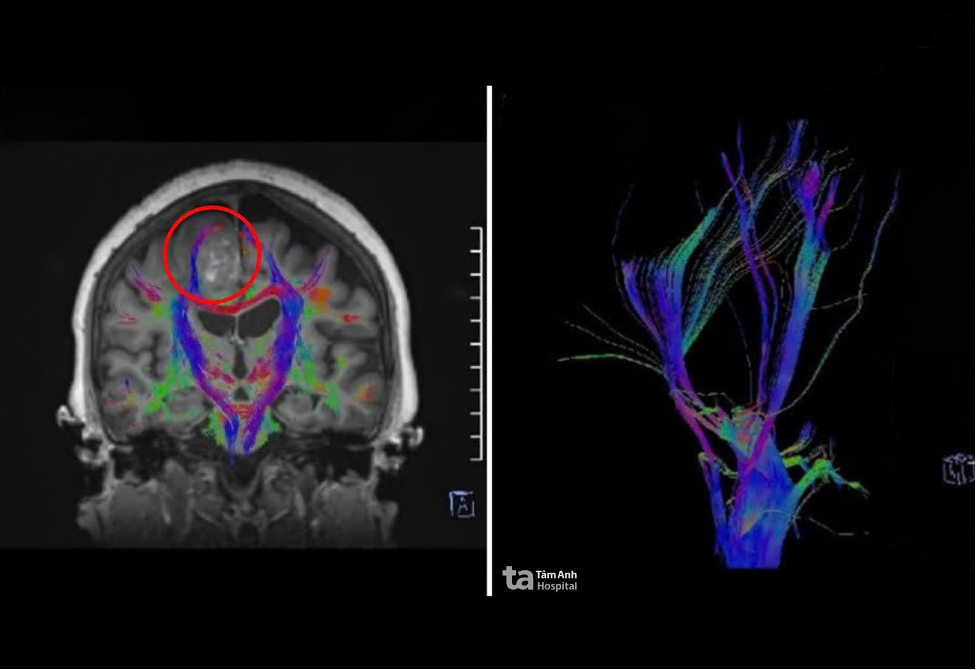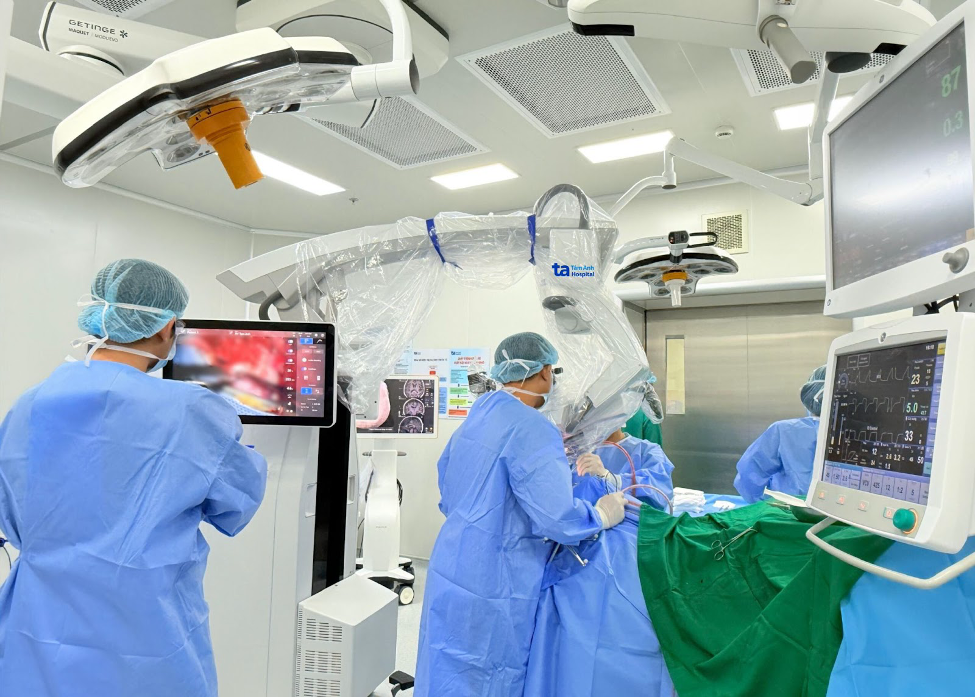Upon arrival at Tam Anh General Hospital in Ho Chi Minh City, Khuyen presented with reduced muscle strength in her left arm and leg, down to 3/5, resulting in left-sided weakness. An MRI scan of her brain revealed a 2.5 cm tumor in the right frontal-parietal region.
Dr. Ly Gia Cuong from the Emergency Department explained that the tumor caused widespread brain swelling, compressing the right frontal horn of the lateral ventricle, the control center for left-side body movement. Numerous nerve fibers were intertwined around the tumor. Doctors also found two smaller lesions in both sides of the cerebellum, suspected to be metastases from the lungs, as the MRI also revealed a lung tumor.
Khuyen was transferred to the Neurosurgery Department for intracranial decompression surgery and a biopsy to determine the type of cancer. Before the operation, the surgical team conducted Diffusion Tensor Imaging (DTI) to reconstruct the nerve fibers in her brain, enabling them to choose a safe surgical approach and location. The DTI images clearly displayed the motor nerve bundles in blue and purple, encircling the tumor like a functional barrier.
Dr. Mai Hoang Vu from the Neurosurgery Department, Center for Neuroscience, Tam Anh General Hospital in Ho Chi Minh City, explained that a direct approach from the right side of the brain would necessitate cutting through these nerve fibers, posing a high risk of damage. Thanks to the detailed DTI images, the doctors opted to approach from the left side of the brain, where there was more space, minimizing the impact on Khuyen’s neurological functions post-surgery.
 |
DTI image showing the motor and sensory nerve fibers surrounding Khuyen's brain tumor. *Photo: Tam Anh General Hospital* |
After careful analysis, the team chose to open the skull on the left side, crossing the interhemispheric fissure and falx cerebri to reach the tumor on the right. This optimal approach allowed them to navigate through an area devoid of nerve fibers, minimizing the risk of affecting functional areas and maximizing the chances of preserving motor function after surgery.
The surgical team employed the minimally invasive Brain Path technique, creating a small 3 cm "pathway" instead of the traditional 8-10 cm skull opening. A navigation system guided the instruments precisely to the tumor, allowing the surgeons to carefully dissect and remove the entire mass without damaging the functional areas. The surgery lasted nearly three hours and concluded without any residual tumor tissue or bleeding complications.
Three days post-operation, Khuyen was alert, responsive, and experienced reduced headaches. The biopsy confirmed lung adenocarcinoma metastasized to the brain. This was the first time Khuyen was diagnosed with lung cancer, which had subsequently spread to her brain. She is currently under observation and will receive appropriate treatment for lung cancer.
 |
Doctors used the AI Kinevo 900 surgical microscope to assist in removing Khuyen's brain tumor. *Photo: Tam Anh General Hospital* |
Dr. Vu noted that lung cancer has the highest rate of brain metastasis, accounting for 20-40% of brain metastasis cases. Many cases are detected only when the brain metastasis causes neurological symptoms such as limb weakness, headaches, behavioral changes, or speech difficulties. Surgery helps relieve intracranial pressure, improve symptoms, and improve prognosis. However, for primary lung cancer, patients require further treatment such as chemotherapy, immunotherapy, or targeted therapy to manage and control the disease.
Even in advanced stages, metastatic lung cancer to the brain has many modern treatment options, personalized based on genetic characteristics and immune response. Timely treatment with newer therapies can improve patient health and quality of life. Doctors recommend regular health check-ups, especially for those living in polluted environments, smokers, or those with a family history of cancer, to detect potential issues early. Anyone experiencing unusual neurological signs like limb weakness, speech difficulties, persistent headaches, or loss of balance should seek immediate medical attention for timely diagnosis and treatment.
Phuong Pham - Nhat Thanh
*The patient's name has been changed*
| Readers can submit questions about neurological diseases here for doctors to answer. |












